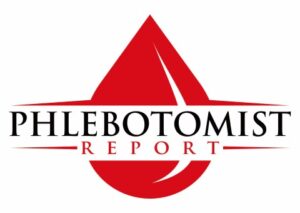When I say “sharps” I am talking about needles, infusion sets and lancets that are used when drawing blood or when doing a finger stick. These sharps are to be used and handled properly to avoid any accidents or needle stick injuries.
It’s not only about how to properly dispose of them after they have been used but it’s also important to know how to use them in the right way so that we avoid any injuries.
Everyday we use sharps and come into contact with them. Here are some steps you can take to ensure safe handling of sharps when performing venipuncture.
1. Preparing for a Safe Blood Draw
Organize Your Work Area
A well-organized and clean work area is the foundation of a safe blood draw. Ensure that your workspace is free from clutter and well-lit to avoid any mishandling of sharps. Have all necessary supplies within easy reach, including:
- Alcohol swabs
- Gauze
- Bandages
- Gloves
- Sharps disposal container
- Needles
- Collection tubes
Having everything you need within arm’s reach minimizes movement and potential accidents during the procedure. When everything is close to you you won’t have to stretch to get something or leave and come back. Remember, you want to avoid any kind of accidents, especially a sharps or blood accident.
Use Personal Protective Equipment (PPE)
Wearing appropriate PPE is crucial for protecting yourself from exposure to blood and other bodily fluids. Always wear gloves when handling sharps and blood. Also, wear a lab coat. You may use a face shield or mask as may be needed or as required by your facility. These PPEs will provide extra protection.
Inspect Sharps Before Use
Before beginning the procedure, inspect all sharps for any signs of damage or defects. Check for bent or broken needles and ensure that all equipment is within its expiry date. Using damaged sharps can increase the risk of injury and infection.
Inspecting will also ensure that you have the right equipment needed to perform the blood draw or finger stick.
2. Performing the Blood Draw
Hand Hygiene
Hand hygiene is one of the most effective ways to prevent the spread of infections. Wash your hands with soap and water or use an alcohol-based hand sanitizer before donning gloves. Proper hand hygiene reduces the risk of contaminating the sharps or the patient’s skin.
Proper Technique for Venipuncture
Using the correct technique is crucial for a safe and effective blood draw:
- Vein Selection: Choose an appropriate vein, usually the median cubital vein in the antecubital fossa, and disinfect the area with an alcohol swab.
- Needle Size: Select the correct needle size for the procedure to ensure patient comfort and effective blood collection.
- Insertion: Insert the needle at a 15 to 30-degree angle to the skin. Avoid unnecessary adjustments to minimize the risk of needle-stick injuries.
Stabilize the Patient’s Arm
Ensuring the patient’s arm is stable and the vein is properly anchored can prevent movement during needle insertion. Use a tourniquet to help locate the vein and stabilize the arm, and ask the patient to remain still during the procedure.
3. Post-Procedure Safety Measures
Activate Safety Features
After drawing blood, immediately activate any safety features on the needle or lancet. Many modern needles come with built-in safety mechanisms, such as retractable tips or shields, to reduce the risk of needle-stick injuries. Engaging these features right away ensures the sharp is safely contained.
Proper Disposal of Sharps
Dispose of used sharps immediately into an approved sharps container. Do not recap the needle, bend, or break it before disposal, as these actions increase the risk of injury. Sharps containers should be:
- Puncture-Resistant: Made of durable material that cannot be easily punctured.
- Leak-Proof: Designed to prevent leaks and spills.
- Labeled: Clearly marked with a biohazard symbol and proper labeling.
Hand Hygiene Post-Procedure
After completing the blood draw and disposing of the sharps, remove your gloves and wash your hands thoroughly. This step is crucial to eliminate any potential contaminants and maintain hygiene.
4. Handling Sharps Containers
Use Approved Containers
Always use approved sharps disposal containers by the government. These containers are designed to safely hold used sharps until they can be properly disposed of. Ensure to do the following:
Do Not Overfill
Sharps containers should not be overfilled. Dispose of the container when it is three-quarters full to prevent needle-stick injuries from overfilling. Overfilled containers can lead to accidental needle sticks when trying to add more sharps.
Seal and Label Containers
Once the sharps container is three-quarters full, ensure it is securely sealed and properly labeled. Follow your local regulations for the disposal of biohazardous waste. Many areas have specific guidelines for how and where to dispose of sharps containers safely.
5. What to Do in Case of a Needle-Stick Injury
Immediate Action
If you experience a needle-stick injury, take immediate steps to minimize the risk of infection:
- Wash the Area: Clean the puncture site with soap and water immediately.
- Apply Antiseptic: Use an antiseptic to disinfect the area thoroughly.
- Seek Medical Attention: Report the incident to your supervisor and seek medical evaluation as soon as possible.
Follow-Up Care
After initial treatment, follow up with any recommended blood tests and prophylactic treatments to prevent infection. Document the incident for workplace safety records and future reference. Regularly reviewing these incidents can help improve safety protocols and prevent future injuries.
Conclusion
Safely handling sharps during blood draws is essential to prevent injuries and the spread of infections. By organizing your workspace, using proper techniques, and following strict disposal protocols, you can ensure a safe and effective procedure.
